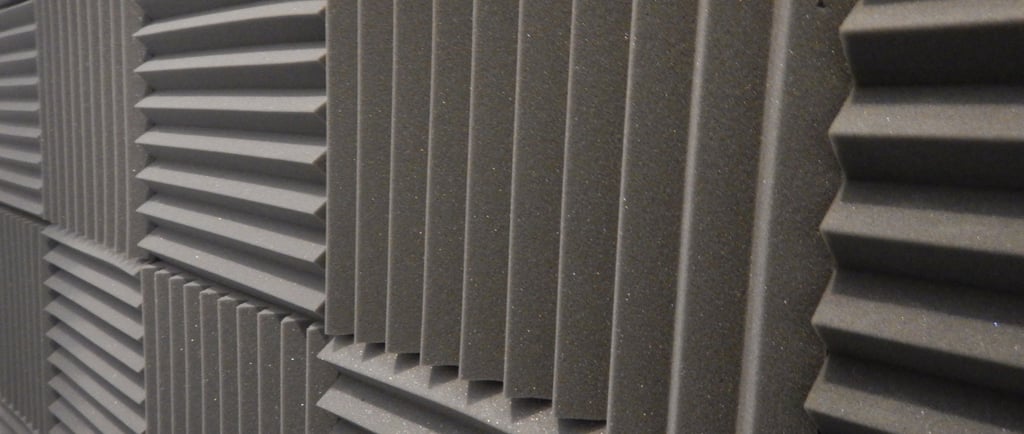Understanding STC (Sound Transmission Class): The Key to Effective Soundproofing
DIGI Acoustics


Introduction:
What is Sound Transmission Class (STC)?
Sound Transmission Class (STC) is an integer rating that measures how well a building partition (like a wall, floor, or door) reduces airborne sound transmission. The higher the STC rating, the better the material or assembly is at blocking sound.
What Is STC? Breaking Down the Basics
Sound Transmission Class (STC) is a numerical rating that indicates how well a building element (like a wall, door, floor, or ceiling) reduces airborne sound transmission.
Think of it as the "silence score" of a material. The higher the STC rating, the better it is at blocking sound from passing through.
“If you can hear the conversation next door, your wall’s STC is trying to tell you something.”
How STC is Measured
STC is determined through standardized lab testing. A sample wall or partition is placed between two rooms, and various frequencies of sound (usually 125 Hz to 4000 Hz) are played from one side. The amount of sound that makes it through to the other side is measured. The difference is used to calculate the STC rating.
Interpreting STC Ratings: What the Numbers Mean
Here’s a quick cheat sheet to help you understand what different STC levels actually sound like in real life:
STC RatingWhat You’ll Hear20-25Very poor. You can hear normal speech clearly.30-35Poor. Loud speech is intelligible.40-45Fair. Loud speech is audible but not intelligible.50-55Good. Loud speech is barely audible.60+Excellent. Most sounds are inaudible.
So, if your goal is privacy or sound isolation—you should aim for STC 55 or higher, especially in studios, conference rooms, or bedrooms in noisy environments.
How to Improve STC in a Space
If your room or building isn’t performing well acoustically, there are proven ways to increase its STC rating:
1. Add Mass
Heavier materials (like multiple layers of drywall, cement boards, or acoustic-rated plywood) block more sound. More mass = less sound penetration.
2. Use Resilient Channels or Sound Isolation Clips
These decouple one surface from another, preventing sound vibrations from transferring directly through walls.
3. Seal Air Gaps
Even a tiny gap can drastically reduce the effectiveness of a high-STC wall. Use acoustic sealants around outlets, ducts, doors, and joints.
4. Install Acoustic Insulation
Materials like rockwool or fiberglass insulation within walls absorb sound energy and reduce transmission.
5. Consider Double-Wall Construction
A room-within-a-room approach, often used in studios, creates air gaps and independent structures, significantly improving STC performance (60+ STC).
Limitations of STC Ratings
STC is great for airborne sounds—like speech, TV noise, and music. But it doesn't account for impact sounds (like footsteps or furniture being dragged). That’s where IIC (Impact Insulation Class) comes in.
Also, STC doesn’t fully capture low-frequency performance. Bass-heavy music, subwoofers, or industrial hums may still leak through walls even with high STC ratings. In these cases, low-frequency soundproofing strategies are necessary.
Choosing the Right STC Rating for Your Space
Here’s a quick guide based on application:
Bedrooms near traffic/noise: STC 50+
Home offices and study rooms: STC 45–55
Shared apartment walls: STC 50–60
Conference or boardrooms: STC 55–65
Recording studios: STC 60+
Cinemas & home theaters: STC 60+
Conclusion:
Is STC the Secret to a Quiet Life?
The answer is: partly, yes.
STC isn’t the whole picture, but it’s a critical piece of the soundproofing puzzle. Whether you're designing a new studio, building a peaceful home, or fitting out a professional space—knowing your STC ratings helps you make smarter choices that impact comfort, privacy, and professionalism.
If you’ve ever been disturbed by noise—or worried about your own being heard—STC is a number worth paying attention to.
Frequently Asked Questions (FAQs)
1. What does STC stand for?
STC stands for Sound Transmission Class. It's a rating that measures how well a material or structure can block airborne sound.
2. Why is STC important in construction and interior design?
STC helps ensure privacy, comfort, and noise control in residential, commercial, and industrial spaces. High-STC walls, ceilings, and floors reduce the transmission of unwanted sound between rooms.
3. What is considered a good STC rating?
An STC rating of 50 or higher is considered good for blocking normal speech and moderate noise. Studios and high-performance rooms often aim for STC 60 or above.
4. How is STC measured?
STC is measured in a lab by playing standardized sound frequencies on one side of a test partition and measuring how much penetrates to the other side.
5. What are typical STC ratings for standard building materials?
Single layer drywall: STC 30–35
Double drywall with insulation: STC 45–50
Soundproof walls with advanced design: STC 60+
6. Can I increase STC in an existing room?
Yes. Adding mass (extra drywall), insulation, acoustic sealants, or using sound isolation clips and resilient channels can improve the STC rating of a room.
7. Does STC cover all types of noise?
No. STC primarily measures airborne sounds (like talking or music). It doesn’t account for impact noise (like footsteps), which is measured by IIC (Impact Insulation Class).
8. Is STC relevant for home theaters and studios?
Absolutely. High-STC-rated construction is essential to contain sound within a studio or home theater and to keep external noise out, ensuring professional-grade acoustics.
9. What's the difference between soundproofing and acoustic treatment?
Soundproofing focuses on blocking sound (STC-related), while acoustic treatment improves the quality of sound within a room by controlling reflections and echoes.
10. Can DIGI Acoustics help with STC-rated solutions?
Yes! DIGI Acoustics specializes in soundproofing and acoustic solutions, offering STC-optimized wall systems, doors, ceilings, and custom treatments for all types of spaces.
At DIGI Acoustics, we help you build that barrier between you and the noise. Our soundproofing and acoustic design solutions combine STC-rated materials, professional installation, and visual elegance—tailored for your space.
“Don’t just build walls. Build silence.”
we provide expert acoustics and soundproofing solutions
Important Links
+91 9100720404
© 2025 DIGI Acoustics. All rights reserved.
2-22-1/173/1, Bhagya Nagar Colony, Kukatpally, Hyderabad, Telangana 500072
Address


